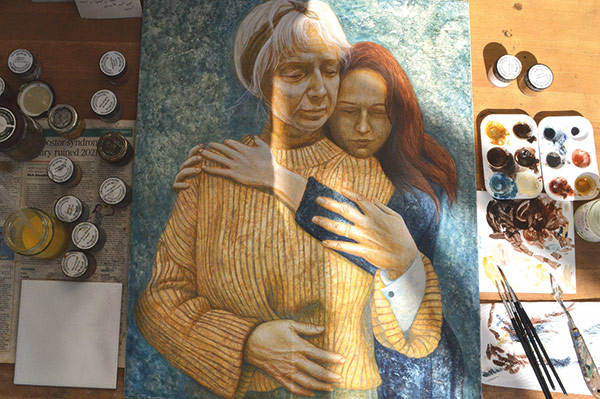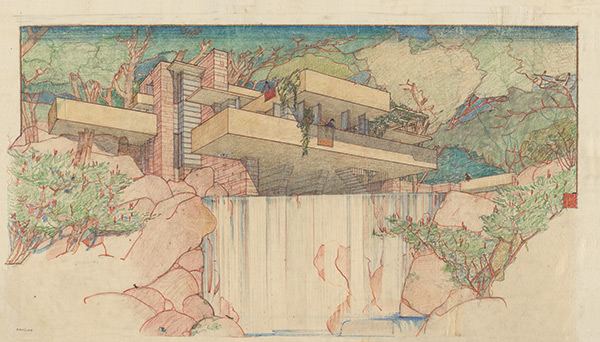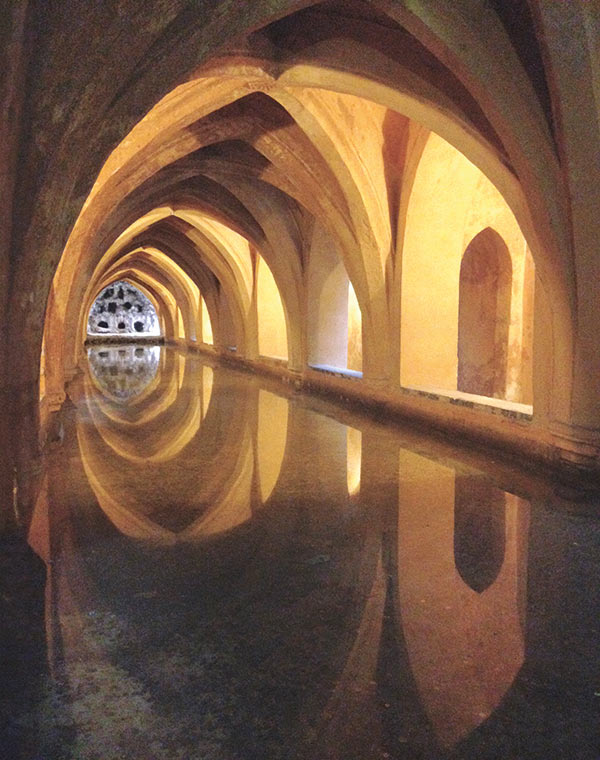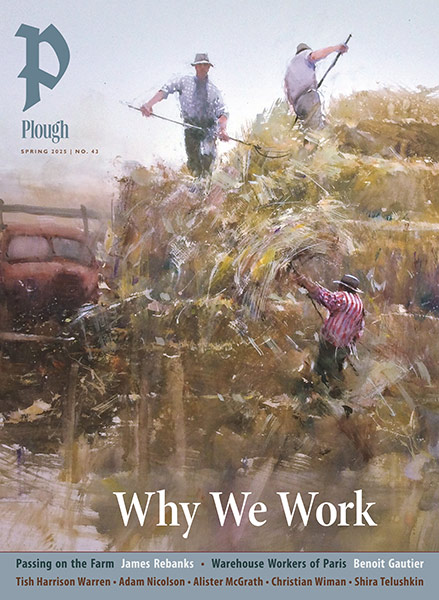Subtotal: $
Checkout-

Paraguayans Don’t Read
-

The Bible’s Story of Freedom
-

The Autonomy Trap
-

Yearning for Freedom
-

We Will Not Be Silent
-

Freedom of Speech Under Threat
-

Editors’ Picks: Demon Copperhead
-

Readers Respond
-

Humanizing Medicine
-

The Forgiveness Project
-

Jakob Hutter, Radical Reformer
-

Watching the Geminids
-

In Defiance of All Powers
-

The Workers and the Church
-

The Body She Had
-

A Lion in Phnom Penh
-

Become Slaves to One Another

Form and Freedom
A visual artist, an architect, and a poet celebrate the freedom of coloring within the lines.
By Hannah Rose Thomas, C. M. Howell and Malcolm Guite
September 21, 2024
Next Article:
Explore Other Articles:
In the cultural imagination, the artist is a free spirit. This is perhaps an inheritance from Romanticism, in which the artist stands as the antithesis to the overly rationalistic and capitalistic habits of modernity and the Industrial Revolution. As a result of this, we imagine artists as nonconformists, ruled by intuition and impulse, difficult to pin down, difficult, even, to count on. But the reality for most working artists is a daily life involving a rigor, routine, and precision that we don’t typically associate with “free spirits.” The musician must master the beat and musical structures of the twelve-bar blues before she can transgress them with the finesse and boldness that epitomizes jazz. The painter tediously prepares canvas and paints to produce a work of visual depth. The dancer’s free and graceful movements flow from decades of disciplined training and daily repetition of technique.
Below, three artists from different disciplines reflect on the interplay between freedom and structure in their work. Far from inhibiting freedom, these artists find that it is often through accepting formal limitations, structure, and routine that their practice can become intuitive and free-flowing. —Joy Marie Clarkson
The Discipline of Egg Tempera
Hannah Rose Thomas
In the painting process, there is a subtle balance between structure and creative freedom, discipline and spontaneity. I am especially conscious of this tension in the traditional painting methods I use. My portrait paintings are rooted in the symbolism and painting techniques used in Byzantine iconography and the early Renaissance, and yet they address contemporary themes such as forced displacement, religious and ethnic persecution, and sexual violence in conflict. While the subject matter is contemporary, traditional techniques and an attentive, prayerful approach remain at the heart of these paintings.
I tend to work in egg tempera, which is a beautiful medium that requires a methodical, disciplined, and craftsman-like approach. Freedom can be found within discipline and limitations. While it may seem paradoxical, discipline provides the structure, consistency, and concentrated focus for creativity to flourish.
I begin the day preparing the natural pigments by hand and mixing them with the natural binder, egg yolk. This helps still my mind and heart before I start painting. It is a meditative process that cultivates a ritual preparedness, an invitation to attendance and reverence. Tempera can only be applied in thin, translucent layers, and it has a very fast drying time. Therefore, it takes innumerable layers of paint to build up the finished portrait. I begin by modeling shadow, then light, for the tonal underpainting in verdaccio before adding glazes of color. It is a process that cannot be rushed; any attempts to apply thicker paint layers make it difficult to achieve harmonious tonal transitions. This makes tempera a less spontaneous medium than oil paint. However, the jewel-like luminosity of color and the depth of presence in an egg tempera painting is a mystery that emerges through the rich beauty of the layering process.

Hannah Rose Thomas, Maria and Nadiia, portrait work in progress, egg tempera on panel, 2022. Used by permission.
The repetitive brushstrokes of translucent paint require patient attention. For the British novelist and philosopher Iris Murdoch, art “demands moral effort and teaches quiet attention.” Murdoch elevates attention as integral to the moral and ethical life. Likewise, the painstaking egg tempera methods of the early Renaissance, and, in some of the paintings, the use of gold leaf, is integral to my ethics and aesthetics. These techniques are how I seek to respond to, honor, and revere the stories that I have heard. The theologian Rowan Williams highlights the importance of the “reverence, patience, time-taking between agents in creation” that demands an “awareness of the impenetrable mysteriousness of the other’s hinterland and gratitude for life-giving.”
To create is an act of faith. It is to persevere in the hope that the elusive “impenetrable mysteriousness” of the other will shimmer through the layers of paint. In the painting process there is a delicate balance between a perfectionist drive for artistic mastery and a humble searching and receptive openness, a vulnerability before the unknown.
Architecture’s Crisis of Freedom
C. M. Howell
The most formative technological advancement for building design was the production of steel. Sir Henry Bessemer developed efficient means for the alloy’s production in the middle of the nineteenth century. And it was not long after, in the 1880s, that Burnham and Root architects completed the Rand-McNally building in Chicago – the first all-steel framed skyscraper. Bessemer’s innovation took on new forms as further advancement in construction materials continued throughout the twentieth century. From reinforced concrete to lightweight alloys, architecture became proof of the Enlightenment’s claims to advancement.
Since the inauguration of culture, buildings were historically constrained to the statical limitations of their materials. A building could only be as tall as the base layer of stones could support. Its openings only as wide as the integrity of its arches. Its span only as great as its columns could withstand. The classical orders were mathematically precise formulas to ensure the structural stability and public safety of buildings. The Greeks were just as concerned with physics as they were with aesthetics.
All of this changed with steel. Architecture was liberated from its natural limitations. And as such, the art of architecture was presented with an identity crisis. What norms should govern this newfound freedom? What does this freedom mean for humanity’s relationship to nature?
In modern architecture, the question of freedom was never really one of unbridled spontaneity but always one of what to do with the limited capacity of freedom.
Modern architecture took form as an attempt to answer this question. German-American architect Ludwig Mies van der Rohe, representing one position, sought to fully embrace the novel possibilities of buildings, in order to establish a new connection with nature. He saw that modern materials could erase the stringent dichotomy of inside-outside in buildings. Beginning with his Pavilion in Barcelona (1929) and perhaps perfected in his Farnsworth House outside Chicago (1946–51), he used steel to span entire lengths of a structure, infilling its frame wholly with glass. To be in these buildings was to be in immediate sight of what lay outside. It was to be protected, but never fully detached from nature. American architect Frank Lloyd Wright, taking another position, strove to reflect the aesthetics of nature through structural innovations. Not only does his Prairie style utilize the materials local to the site, he also realized buildings could reflect the natural topography. Fallingwater is an exquisite example, as it mimics the shape of its mountainous setting.

Frank Lloyd Wright, Fallingwater, color pencil on tracing paper, 1935. © The Frank Lloyd Wright Foundation. Used by permission.
These modernists reveal that even with technological innovation humans are always tethered to the natural realm. Their design approaches, in fact, attempt to honor this relationship. But they only see such honor as valid if it happens in congruency with the historical moment. The retrieval movements of premodern architecture – neoclassical, neo-Gothic, etc. – are, structurally, farces. Supported by steel, their façades are nostalgic whimpers. Their appearances hide their modern essence.
In modern architecture, the question of freedom was never really one of unbridled spontaneity but always one of what to do with the limited capacity of freedom. Undoubtedly, the emphasis is slightly tilted to the former aspect. But the deep reality of the natural world will never completely loosen its grasp. Architecture is forced to recognize this limitation, and thus, can serve as a reminder to our more abstract musings on freedom.
Reflections on the Sonnet
Malcolm Guite
I have found that in the composition of sonnets the form itself, far from constraining me, gives me freedom. It enables me to say things with a power, a concentration, a fully embodied form, that a freer and perhaps more rambling exercise in vers libre could not attain. This paradox, that we find freedom through form, has been frequently attested and indeed explored by poets who have chosen to write in form, particularly in the sonnet form. Samuel Daniel, the Elizabethan and Jacobean poet who wrote a sonnet sequence called Delia, puts it very well in his A Defence of Ryme: “Ryme is no impediment to his conceit, rather giues him wings to mount and carries him, not out of his course, but as it were beyond his power to a farre happier flight.”
Time and again I have had this experience of being carried “beyond my power” to “a far happier flight.” Something far more generative, more creative, is drawn from me in the very exercise of keeping to my self-imposed boundaries. The “bounding line,” as William Blake called it, is, in the very act of setting a boundary, concentrating the energy of the poem, like the banks of a river channeling the current that might otherwise dissipate in a tepid lake. The poet in Timon of Athens says poetry is “a current [which] flies each bound it chafes.” The very effort to channel it is what gives the current force, and of course the “bound,” the end of the line, or the turn of the sonnet can sometimes be overrun to great effect – the poem can fly the bound. Yet even that freedom to play with and stretch the rule is not an effect one can achieve without the self-imposed rule.

Hannah Rose Thomas, Islamic architecture reflects the purity and calm elsewhere found in nature, photograph with filter, 2016. Used by permission.
But there is much more at stake here than literary style. In making these choices we are ultimately concerned with beauty, truth, and goodness. The first reason for choosing the sonnet form is beauty – it is a beautiful form in itself, as Daniel also emphasizes in the same work quoted above: “Euery language hath her proper number or measure fitted to vse and delight, which … by the allowance of the Eare, doth indenize, and make naturall. All verse is but a frame of wordes confinde within certaine measure; differing from the ordinarie speach, and introduced, the better to expresse mens conceipts, both for delight and memorie.” There are beauties, attractions for both the “eare” and the eye that are unique to the sonnet form. As the contemporary poet Don Paterson puts it in his introduction to his anthology 101 Sonnets: From Shakespeare to Heaney, “It presents both poet and reader with a vivid symmetry that is the perfect emblem of the meaning a sonnet seeks to embody … so a sonnet is a paradox, a little squared circle, a mandala that invites our meditation.”
And what of goodness and truth? Here I have a deeper reason yet for employing the sonnet form. For me it is an act of countercultural resistance. Since the Enlightenment our culture has been besotted with the notion of autonomy, of self-rule, of the isolated will of the individual trumping every other consideration. But in earlier ages, and in my own Christian faith, I find there is a deeper truth at work: that to live from and in obedience to God, who is the sum of all good, is in fact to become free and happy in a way that no amount of self-dictation and private wish fulfillment could approach. It is indeed true that “his service is perfect freedom.” I think of myself, my own life, not as an arbitrary piece of self-expression, but as a poem that is still being spoken by my Creator. He has chosen a particular form for me as a poem. He has set my bounding lines and in keeping to those lines I not only exercise my creativity, but I become more truly myself; I acquire form and coherence. When I tried to express that some years ago, the best form was, naturally, a sonnet:
O Sapientia
I cannot think unless I have been thought,
Nor can I speak unless I have been spoken.
I cannot teach except as I am taught,
Or break the bread except as I am broken.
O Mind behind the mind through which I seek,
O Light within the light by which I see,
O Word beneath the words with which I speak,
O founding, unfound Wisdom, finding me,
O sounding Song whose depth is sounding me,
O Memory of time, reminding me,
My Ground of Being, always grounding me,
My Maker’s Bounding Line, defining me,
Come, hidden Wisdom, come with all you bring,
Come to me now, disguised as everything.
Poem from Sounding the Seasons (Canterbury Press, 2012).
Already a subscriber? Sign in
Try 3 months of unlimited access. Start your FREE TRIAL today. Cancel anytime.






























